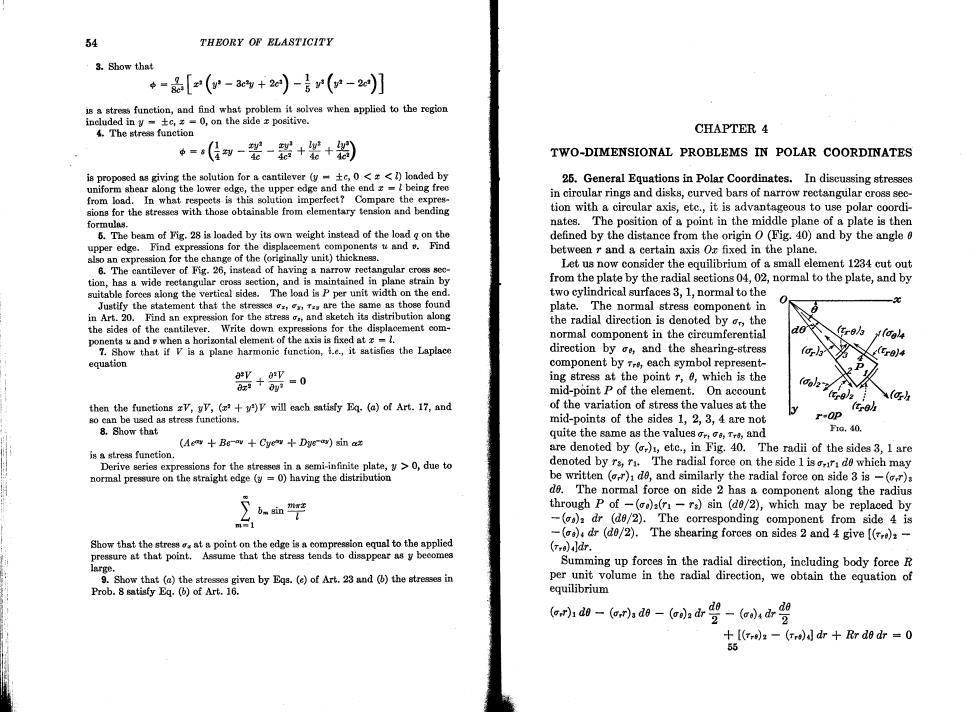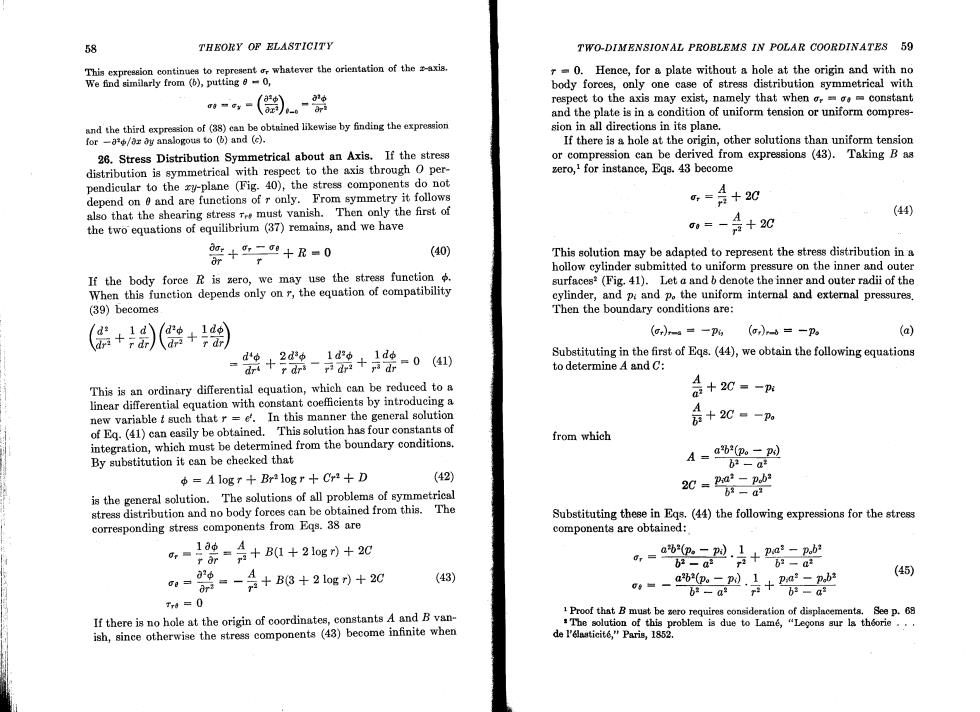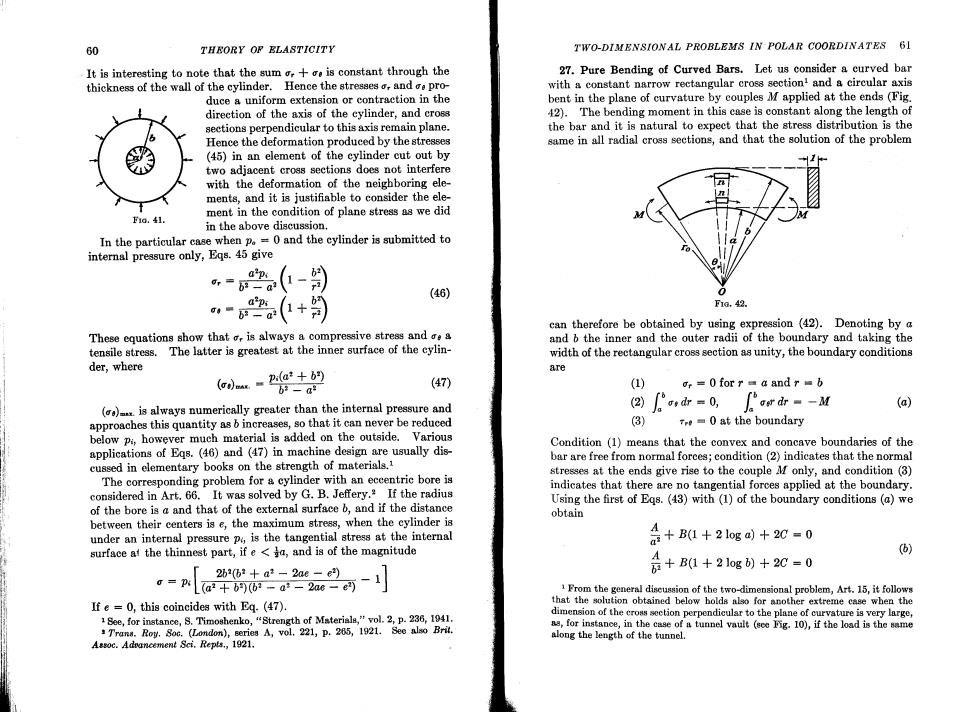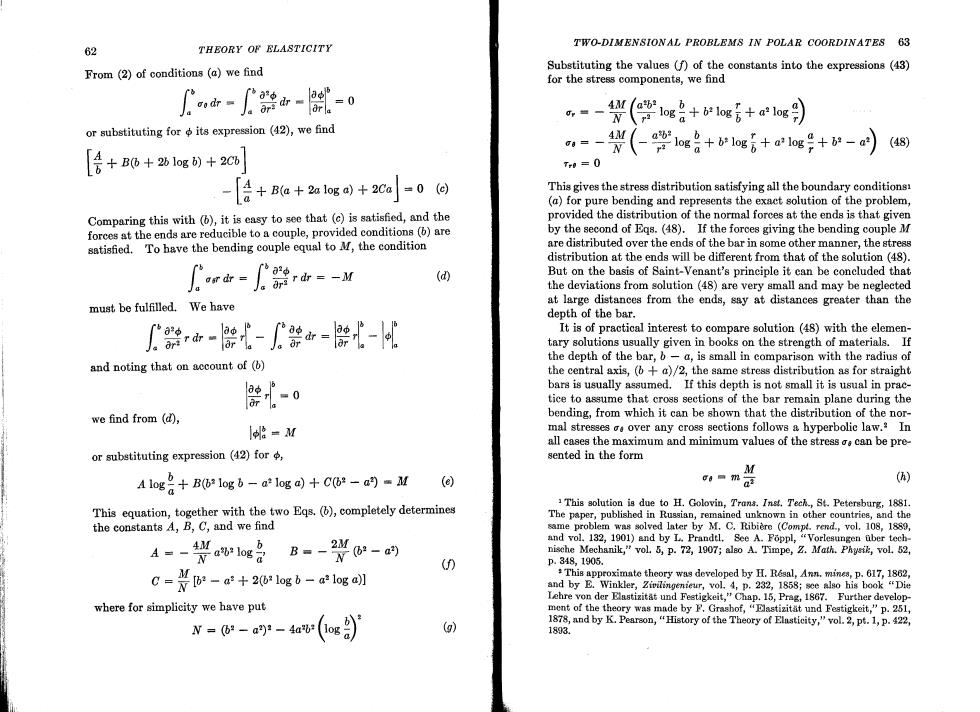
54 THEORY OF ELASTICITY 3.Show that +=品[r(-3+2o)-话r(-2o)] is a stress funetion,and find what problem it solves when applied to the region included in yte-0,on the side x positive. 4.The stress function CHAPTER 4 =(保到-装-器+箬+) TWO-DIMENSIONAL PROBLEMS IN POLAR COORDINATES is proposed as giving the solution for a cantilever (y-c,0<<)londed by 25.General Equations in Polar Coordinates.In discussing stresses uniform shear along the lower edge,the upper edge and the end z-I being free from load.In what respeets is this solution imperfect?Compare the expres- in circular rings and disks,curved bars of narrow rectangular cross sec- sions for the stresses with those obtainable from clementary tension and bending tion with a circular axis,etc.,it is advantageous to use polar coordi- formulns. nates.The position of a point in the middle plane of a plate is then 5.The beam of Fig.28 is loaded by its own weight instead of the load g on the defined by the distance from the origin O(Fig.40)and by the angle 0 upper edge.Find expressions for the displacement components w and v.Find between r and a certain axis Or fixed in the plane. also an expression for the change of the (originally unit)thickness. 6.The cantilever of Fig.26,instead of having a narrow rectangular cross sec- Let us now consider the equilibrium of a small element 1234 cut out tion,has a wide reetangular cross section,and is maintained in plane strain by from the plate by the radial sections 04,02,normal to the plate,and by suitable forees along the vertical sides.The load is P per unit width on the end. two cylindrical surfaces 3,1,normal to the Justify the statement that the stresses are the same as those found plate.The normal stress component in 0 in Art.20.Find an expression for the stress,and sketch its distribution along the radial direction is denoted byor,the the sides of the eantilever.Write down expressions for the displacement com- ponents u and s when a horigontal element of the axis is fixed at z -1. normal component in the circumferential (rel3 y(dol 7.Show that if V is a plane harmonic function,i.e.,it satisfies the Laplace direction by ge,and the shearing-stress (5r0)4 equstion component by rre,each symbol represent- 器+器-0 ing stress at the point r,0,which is the mid-point P of the element.On account (dol2 then the funetions zV,yV,(+y)V will each satisfy Eq.(a)of Art.17,and of the variation of stress the values at the y so can be used as stress funetions. mid-points of the sides 1,2,3,4 are not r-OP 8.Show that quite the same as the values,o,rr,and Fo,40. (Aem Be-v Cye 4 Dyg"v)sin ax is a stress funetion. are denoted by ()1,etc.,in Fig.40.The radii of the sides 3,I are Derive series expressions for the stresses in a semi-infinite plate,y>0,due to denoted by rs,r.The radial force on the side 1 is do which may normal pressure on the straight edge (y=0)having the distribution be written (or)1 do,and similarly the radial force on side 3 is-(r)s de.The normal force on side 2 has a component along the radius through P of-()a(r1-rs)sin (de/2),which may be replaced by -()a dr (de/2).The corresponding component from side 4 is -(o).dr (d0/2).The shearing forces on sides 2 and 4 give [(): Show that the stressat a point on the edge is a compression equal to the applied (Ta)aldr. pressure at that point.Assume that the stress tends to disappear as y becomes Summing up forces in the radial direction,including body force R g心, 9.Show that (a)the stresses given by Egs.(e)of Art.23 and (the stresses in per unit volume in the radial direction,we obtain the equation of Prob.8 satisfy Eq.(b)of Art.16. equilibrium onhd的-6onha0-od盟-(od盟 2 +[()2-(Tr)dr +Rr de dr =0 55

56 THEORY OF ELASTICITY TWO-DIMENSIONAL PROBLEMS IN POLAR COORDINATES 57 Dividing by dr de this becomes Using these,and considering as a function of r and 8,we find (c))a do Br 0φ0中dr dr de 院-器新+胎股-”am0-品血0 If the dimensions of the element are now taken smaller and smaller,to To get the second derivative with respect to z,it is only necessary to the limit zero,the first term of this equation is in the limit a(r)/ar. repeat the above operation;hence The second becomes o,and the third are/a0.The equation of equi- librium in the tangential direction may be derived in the same manner. 02中 The two equations take the final form )c-路血) a2中 架++,”+R=0 c0e2g-20中in0cos9+8驶si09+2ap8如9co80 a8 r r (37) 韶++平-0 + (b) f In the same manner we find These equations take the place of Egs.(18)when we solve two- dimensional problems by means of polar coordinates.When the body force R is zero they are satisfied by putting 器-票0+2血0+驶g9 80 ar r dr r =踪+器 102中 -2 C,= 韶血00a9+胎og9 08r 2φ Adding together (b)and (c),we obtain 0s-ar (38) 1a2φ m-路-。=-(阁) r+折+30 (d) Using the identity where is the stress function as a function of r and 0.This of course may be verified by direct substitution.A derivation of(38)is ineluded 器+2+器-(品+别)+别》 'Φ in what follows. To yield a possible stress distribution,this function must ensure that the condition of compatibility is satisfied.In Cartesian coordinates and Eq.(d),the compatibility equation (a)in polar coordinates (see page 26)this condition is becomes +2、0" d*中 ”n+器-0 (a) (儡++别(+驶+ 1=0 (39) From various solutions of this partial differential equation we obtain For the present purpose we need this equation transformed to polar coordinates.The relation between polar and Cartesian coordinates is solutions of two-dimensional problems in polar coordinates for various boundary conditions.Several examples of such problems will be dis- given by cussed in this chapter. The first and second of the expressions (38)follow from Eqs.(b)and (c).If from which we choose any point in the plate,and let the z-axis pass through it,we have 0, ==c08, or andare the same,for this particular point,as Thus from (e),putting ax r arsin 0 8=0, ae --0 oy (别).+器

58 THEORY OF ELASTICITY TWO-DIMENSIONAL PROBLEMS IN POLAR COORDINATES 59 This expression continues to represent whatever the orientation of the axis. r=0.Hence,for a plate without a hole at the origin and with no We find similarly from (b),putting -0, body forces,only one case of stress distribution symmetrical with 8■gg■ respect to the axis may exist,namely that when or=constant and the plate is in a condition of uniform tension or uniform compres- and the third expression of (38)can be obtnined likewise by finding the expression sion in all directions in its plane. for -a/o ay analogous to (b)and (c). If there is a hole at the origin,other solutions than uniform tension 26.Stress Distribution Symmetrical about an Axis.If the stress or compression can be derived from expressions (43).Taking B as distribution is symmetrical with respect to the axis through o per- zero,1 for instance,Eqs.43 become pendicular to the zy-plane (Fig.40),the stress components do not A depend on 0 and are functions of r only.From symmetry it follows ,=+20 also that the shearing stress r must vanish.Then only the first of (44) the two equations of equilibrium(37)remains,and we have +20 0:++R=0 (40 This solution may be adapted to represent the stress distribution in a hollow eylinder submitted to uniform pressure on the inner and outer If the body force R is zero,we may use the stress function surfaces*(Fig.41).Let a and b denote the inner and outer radii of the When this function depends only on r,the equation of compatibility cylinder,and pi and p.the uniform internal and external pressures. (39)becomes Then the boundary conditions are: d ,1d 中 1dφ (a)r-a=一p% (G,)=-Pa (a) r dr 器-器+=0四 中+2中一1中 Substituting in the first of Eqs.(44),we obtain the following equations to determine A and C: This is an ordinary differential equation,which can be reduced to a +2C=-p A linear differential equation with constant coefficients by introducing a A new variable i such that r =e.In this manner the general solution +2C。-% of Eq.(41)can casily be obtained.This solution has four constants of from which integration,which must be determined from the boundary conditions. By substitution it can be checked that A=ab"(P-p) b2-a2 =A logr+Br2logr +Cr2+D (42) 2C Pxa:-pb* is the general solution.The solutions of all problems of symmetrical b-a stress distribution and no body forces can be obtained from this.The Substituting these in Eqs.(44)the following expressions for the stress corresponding stress components from Egs.38 are components are obtained: F=+B(1+21og)+2C 1a中A 0,■ a片+二 03-a2 +B(3+2 logr)+20 26 A (43) a6(p。-p).1 (45) b2-a8 Tr4=0 baDi pbs If there is no hole at the origin of coordinates,constants A and B van- 1Proof that B must be zero requires consideration of displacements.See p.68 The solution of this problem is due to Lame,"Legons sur la theorie... ish,since otherwise the stress components (43)become infinite when de I'lasticite,"Paris,1852

60 THEORY OF ELASTICITY TWO-DIMENSIONAL PROBLEMS IN POLAR COORDINATES 61 It is interesting to note that the sum o+e is constant through the 27.Pure Bending of Curved Bars.Let us consider a curved bar thickness of the wall of the cylinder.Hence the stresses o,and e pro- with a constant narrow rectangular cross section!and a circular axis duce a uniform extension or contraction in the bent in the plane of curvature by couples M applied at the ends(Fig. direction of the axis of the cylinder,and cross 42).The bending moment in this case is constant along the length of sections perpendicular to this axis remain plane. the bar and it is natural to expect that the stress distribution is the Hence the deformation produeed by the stresses same in all radial cross sections,and that the solution of the problem (45)in an element of the eylinder cut out by two adjacent cross sections does not interfere with the deformation of the neighboring ele- ments,and it is justifiable to consider the ele- ment in the condition of plane stress as we did Fio.41. in the above discussion. In the particular case when p.=0 and the eylinder is submitted to internal pressure only,Egs.45 give aps =0-2 0 a'pi b (46) -a2 1+ F1a,42. can therefore be obtained by using expression (42).Denoting by a These cquations show that or is always a compressive stress and e a and b the inner and the outer radii of the boundary and taking the tensile stress. The latter is greatest at the inner surface of the cylin- width of the rectangular cross section as unity,the boundary conditions der,where (o)=p(a2+b的 are 2-a2 (47) (1) or =0 for r a andrb (is always numerically greater than the internal pressure and (2) Lond-0.pardr-it (a) approaches this quantity as b increases,so that it can never be reduced (3) =0 at the boundary below pi,however much material is added on the outside.Various Condition (1)means that the convex and concave boundaries of the applications of Egs.(46)and (47)in machine design are usually dis- bar are free from normal forces;condition (2)indicates that the normal cussed in elementary books on the strength of materials.1 stresses at the ends give rise to the couple Mf only,and condition(3) The corresponding problem for a cylinder with an eccentric bore is considered in Art.66.It was solved by G.B.Jeffery.*If the radius indicates that there are no tangential forces applied at the boundary. of the bore is a and that of the external surface b,and if the distance Using the first of Eqs.(43)with (1)of the boundary conditions (a)we obtain between their centers is e,the maximum stress,when the cylinder is under an internal pressure p is the tangential stress at the internal a+B(1+2 log a)+2C=0 surface at the thinnest part,if e<a,and is of the magnitude 6) 。-[0志2-刂 F+B(1+21og)+2C=0 From the general discussion of the two-dimensional problem,Art.15,it follows If e =0,this coincides with Eq.(47). that the solution obtained below holds also for another extreme case when the See,for instance,S.Timoshenko,"Strength of Materials,"vol.2,p.236,1941. dimension of the eross section perpendicular to the plane of curvature is very large, Trans.Roy.Soc.(London),Beries A,vol.221,p.265,1921.See also Brit. as,for instance,in the case of a tunnel vault (sce Fig.10),if the load is the same along the length of the tunnel. Assoc.Adpancement Sci.Repls.,1921

62 THEORY OF ELASTICITY TWO-DIMENSIONAL PROBLEMS IN POLAR COORDINATES 63 From (2)of conditions (a)we find Substituting the values (f)of the constants into the expressions (43) for the stress components,we find 4Ma62, or substituting for its expression (42),we find 4M( (48) +B(6+2b1og)+2C6 T0=0 +B(a 2a log a)2Ca =0(c) This gives the stress distribution satisfying all the boundary conditions (a)for pure bending and represents the exact solution of the problem, Comparing this with (6),it is easy to see that (c)is satisfied,and the provided the distribution of the normal forces at the ends is that given forces at the ends are reducible to a couple,provided conditions(b)are by the second of Eqs.(48).If the forces giving the bending couple M satisfied. To have the bending couple equal to M,the condition are distributed over the ends of the bar in some other manner,the stress distribution at the ends will be different from that of the solution (48). r由=nr= (d) But on the basis of Saint-Venant's principle it can be concluded that the deviations from solution(48)are very small and may be neglected must be fulfilled. We have at large distances from the ends,say at distances greater than the depth of the bar. It is of practical interest to compare solution (48)with the elemen- Ja -=-°-e- tary solutions usually given in books on the strength of materials.If the depth of the bar,b-a,is small in comparison with the radius of and noting that on account of (b) the central axis,(o+a)/2,the same stress distribution as for straight =-0 bars is usually assumed.If this depth is not small it is usual in prac- tice to assume that cross sections of the bar remain plane during the we find from (d), bending,from which it can be shown that the distribution of the nor- =M mal stresses over any cross sections follows a hyperbolic law.?In all cases the maximum and minimum values of the stress g can be pre- or substituting expression(42)for中, sented in the form M A log(loga og) (e) com mai (h) This equation,together with the two Eqs.()completely determines This solution is due to H.Golovin,Trans.Inst.Tech.,St.Petersburg,1881. The paper,published in Russian,remained unknown in other countries,and the the constants A,B,C,and we find same problem was solved Iater by M.C.Ribiere (Comp.rend.,vol.108,1889, B=-兴0-网 and vol.132,1901)and by L.Prandtl.See A.Foppl,"Vorlesungen aber tech- 4-兴o1og2 nische Mechanik,"vol 5,p.72,1907;also A.Timpe,Z.Math.Physik,vol.52, (0 p.348,1905. a+2(0 log a log a) :This approximate theory was developed by H.Resal,Ann.mines,p.617,1862, and by E.Winkler,Zivilingenieur,vol.4,p.232,1858;se also his book "Die Lehre von der Elastizitat und Festigkeit,"Chap.15,Prag,1867.Further develop- where for simplicity we have put ment of the theory was made by F.Grashof,"Elastizitat und Festigkeit,"p.251, -(-)-tar (log (g) 1878,and by K.Pearaon,"History of the Theory of Elasticity,"vol.2,pt.1,p.422, 1893